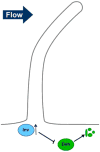Emerging role of primary cilia as mechanosensors in osteocytes
- PMID: 23201223
- PMCID: PMC3624072
- DOI: 10.1016/j.bone.2012.11.016
Emerging role of primary cilia as mechanosensors in osteocytes
Abstract
The primary cilium is a solitary, immotile microtubule-based extension present on nearly every mammalian cell. This organelle has established mechanosensory roles in several contexts including kidney, liver, and the embryonic node. Mechanical load deflects the cilium, triggering biochemical responses. Defects in cilium function have been associated with numerous human diseases. Recent research has implicated the primary cilium as a mechanosensor in bone. In this review, we discuss the cilium, the growing evidence for its mechanosensory role in bone, and areas of future study.
Copyright © 2012 Elsevier Inc. All rights reserved.
Figures





Similar articles
-
Osteocyte primary cilium and its role in bone mechanotransduction.Ann N Y Acad Sci. 2010 Mar;1192:422-8. doi: 10.1111/j.1749-6632.2009.05243.x. Ann N Y Acad Sci. 2010. PMID: 20392268 Free PMC article. Review.
-
The solitary (primary) cilium--a mechanosensory toggle switch in bone and cartilage cells.Cell Signal. 2008 Jun;20(6):1019-24. doi: 10.1016/j.cellsig.2007.12.001. Epub 2007 Dec 8. Cell Signal. 2008. PMID: 18248958 Review.
-
Osteocytes and Primary Cilia.Curr Osteoporos Rep. 2023 Dec;21(6):719-730. doi: 10.1007/s11914-023-00819-1. Epub 2023 Sep 8. Curr Osteoporos Rep. 2023. PMID: 37682373 Free PMC article. Review.
-
Primary cilia: Cell and molecular mechanosensors directing whole tissue function.Semin Cell Dev Biol. 2017 Nov;71:42-52. doi: 10.1016/j.semcdb.2017.08.036. Epub 2017 Aug 24. Semin Cell Dev Biol. 2017. PMID: 28843978 Free PMC article. Review.
-
Adenylyl cyclase 3 regulates osteocyte mechanotransduction and primary cilium.Biochem Biophys Res Commun. 2021 Oct 8;573:145-150. doi: 10.1016/j.bbrc.2021.08.033. Epub 2021 Aug 12. Biochem Biophys Res Commun. 2021. PMID: 34411897 Free PMC article.
Cited by
-
Polycystin-2 mediates mechanical tension-induced osteogenic differentiation of human adipose-derived stem cells by activating transcriptional co-activator with PDZ-binding motif.Front Physiol. 2022 Aug 24;13:917510. doi: 10.3389/fphys.2022.917510. eCollection 2022. Front Physiol. 2022. PMID: 36091380 Free PMC article.
-
Effects of Osteocyte Shape on Fluid Flow and Fluid Shear Stress of the Loaded Bone.Biomed Res Int. 2022 May 30;2022:3935803. doi: 10.1155/2022/3935803. eCollection 2022. Biomed Res Int. 2022. PMID: 35677099 Free PMC article.
-
Brain regulates weight bearing bone through PGE2 skeletal interoception: implication of ankle osteoarthritis and pain.Bone Res. 2024 Mar 5;12(1):16. doi: 10.1038/s41413-024-00316-w. Bone Res. 2024. PMID: 38443372 Free PMC article.
-
A role for primary cilia in coral calcification?Cell Tissue Res. 2021 Mar;383(3):1093-1102. doi: 10.1007/s00441-020-03343-1. Epub 2020 Dec 16. Cell Tissue Res. 2021. PMID: 33330957 Free PMC article.
-
New Advances in Osteocyte Mechanotransduction.Curr Osteoporos Rep. 2021 Feb;19(1):101-106. doi: 10.1007/s11914-020-00650-y. Epub 2021 Jan 9. Curr Osteoporos Rep. 2021. PMID: 33420631 Free PMC article. Review.
References
-
- van Leeuwenhoek A, Hoole S. The select works of Antony Van Leeuwenhoek, containing his microscopical discoveries in many of the works of nature. Vol. 1800. G. Sidney; p. 348.
-
- Zimmermann KW. Beitrage zur Kenntniss einiger Drusen und Epithelien. Archiv fur Mikroskopische Anatomie. 1898;52:552–706.
-
- Federman M, Nichols G. Bone cell cilia: vestigial or functional organelles? Calcified tissue research. 1974;17:81–5. - PubMed
-
- Murcia NS, Richards WG, Yoder BK, Mucenski ML, Dunlap JR, Woychik RP. The Oak Ridge Polycystic Kidney (orpk) disease gene is required for left-right axis determination. Development (Cambridge, England) 2000;127:2347–55. - PubMed
Publication types
MeSH terms
Grants and funding
LinkOut - more resources
Full Text Sources
Other Literature Sources

